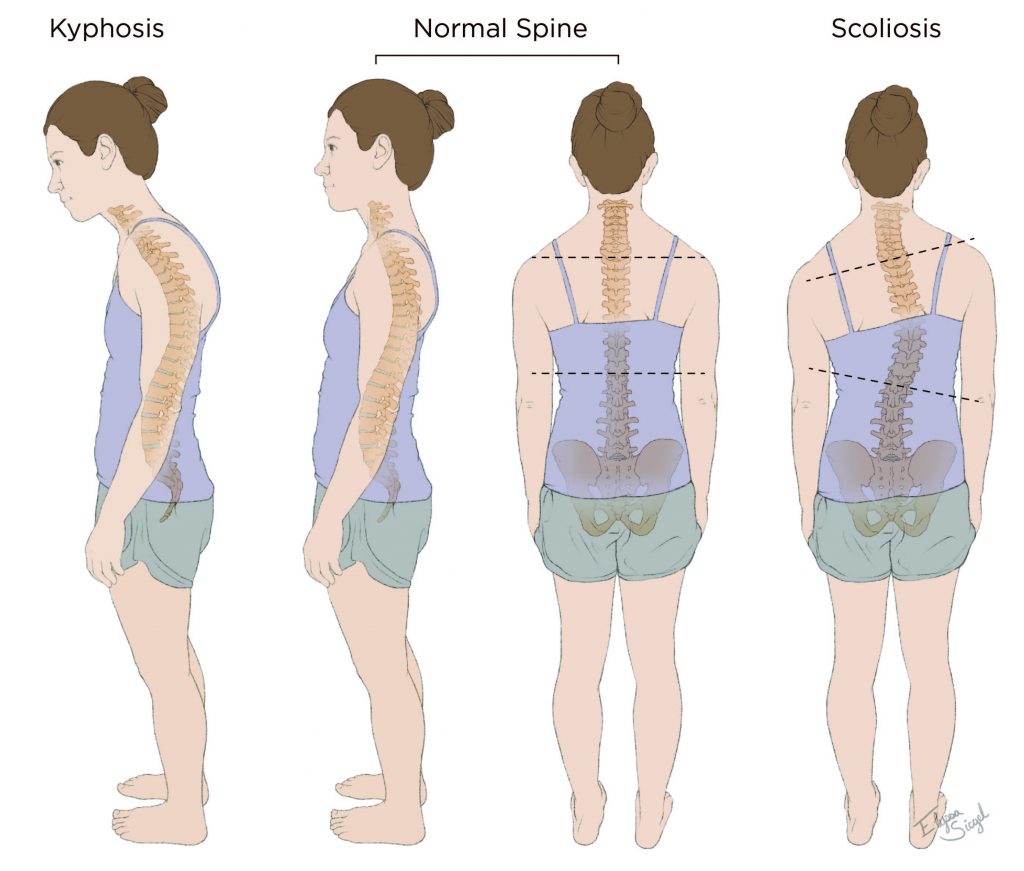Kyphosis/Scoliosis
Normally, the spine has three gentle curves: inward curves (lordosis) at the lumbar and cervical spine; and an outward curve (kyphosis) at the thoracic spine. These three curves allow for the spine to uphold the body over the hips and pelvis and maintain its center of gravity. Abnormal spine curvature does not follow the normal spine curves and results in a loss of the body’s alignment and center of gravity. Kyphosis and scoliosis are two types of abnormal spine curvature. Kyphosis is a forward rounding curve and produces a hunching over or slouching positioning of the spine. Scoliosis is a sideways curve that produces an “S” or “C” shape in the spine.
What’s in this section?
Signs and symptoms
Symptoms depend on the severity and type of spine curvature. The most common symptoms of abnormal spine curvature include:
- Back pain
- Difficulty walking or standing
- Difficulty with balance
- Sciatica
Common symptoms of kyphosis include:
- Bending forward at the neck
- Hump or curve in the upper back
- Back or leg fatigue
Common symptoms of scoliosis include:
- Uneven shoulder blades or waist/hip
- Sideways leaning

Diagnosis
Diagnosis of kyphosis/scoliosis starts with a physical exam and medical history. Other procedures and tests may be needed to diagnose these conditions, including x-rays , computed tomography (CT) or magnetic resonance imaging (MRI) .
Treatment options
There are different treatment options for kyphosis/scoliosis depending on the severity of your symptoms:
- Observation.
- Medication to control pain.
- Physical therapy to strengthen the muscles supporting the spine.
- Back brace
- Spinal deformity correction surgery. This type of surgery is often performed with severe spinal deformities or when the condition leads to restrictions in your daily life, pain or loss of function. During the procedure, your surgeon will relieve any pressure on your spinal cord or any nerves that may be compressed. Bone screws are placed in multiple vertebrae (the bones of the spine). These screws are connected to a rod. The rod is used to “pull” your spine into a more normal alignment. The number of screws and spinal levels depends on the location and severity of the spinal deformity. The surgical correction may require an osteotomy, which is a strategic cut in the vertebra used to loosen your spine and aid in realignment. Additionally, your surgeon may remove some of the intervertebral discs and replace them with a cage, implant or graft in order to aid in the correction of the spinal deformity. After the correction of the deformity, your surgeon will need to take measures to make sure your spinal bones fuse, or grow together. A successful outcome is greatly dependent on the fusion. Your surgeon may use a combination of your own bone, cadaver bone, bone matrix, stem cells and bone morphogenetic protein (BMP) to help your spine fuse.
Conditions
Request an appointment online and we will guide you through the next steps
Get to know the physicians of Goodman Campbell
Goodman Campbell
Patient Stories
Request an appointment online and we will guide you through the next steps.

